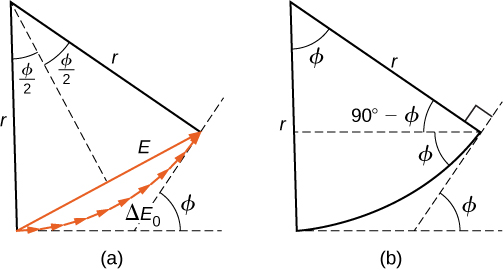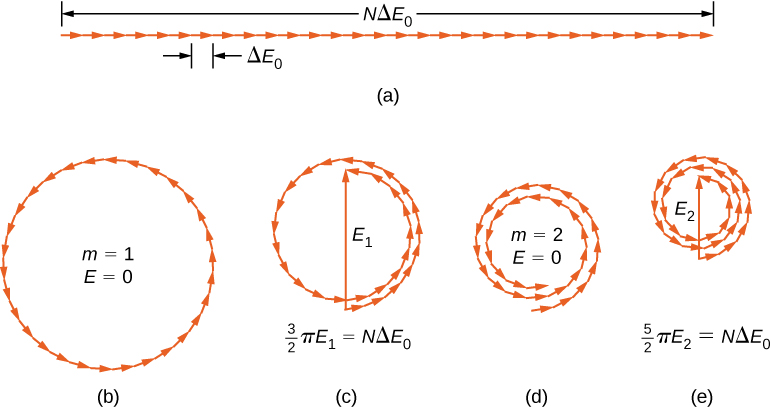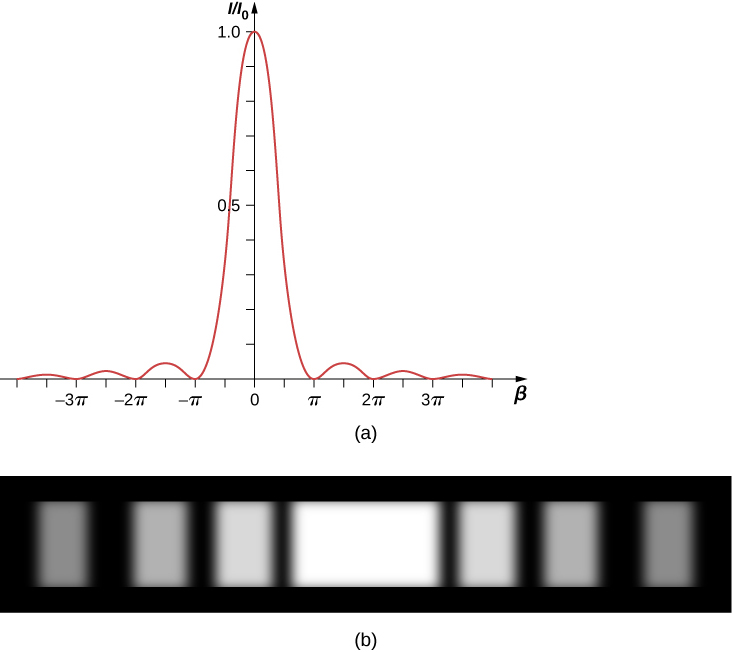13.3: Intensity in Single-Slit Diffraction
- Last updated
- Apr 10, 2025
- Save as PDF
- Page ID
- 107620
( \newcommand{\kernel}{\mathrm{null}\,}\)
Learning Objectives
By the end of this section, you will be able to:
- Calculate the intensity relative to the central maximum of the single-slit diffraction peaks
- Calculate the intensity relative to the central maximum of an arbitrary point on the screen
To calculate the intensity of the diffraction pattern, we follow the phasor method used for calculations with ac circuits in Alternating-Current Circuits. If we consider that there are N Huygens sources across the slit shown previously, with each source separated by a distance a/N from its adjacent neighbors, the path difference between waves from adjacent sources reaching the arbitrary point P on the screen is (a/N)sinθ. This distance is equivalent to a phase difference of (2πa/λN)sinθ. The phasor diagram for the waves arriving at the point whose angular position is θ is shown in Figure 13.3.1. The amplitude of the phasor for each Huygens wavelet is ΔE0, the amplitude of the resultant phasor is E, and the phase difference between the wavelets from the first and the last sources is
ϕ=(2πλ)asinθ.
With N→∞, the phasor diagram approaches a circular arc of length NΔE0 and radius r. Since the length of the arc is NΔE0 for any ϕ, the radius r of the arc must decrease as ϕ increases (or equivalently, as the phasors form tighter spirals).

The phasor diagram for ϕ = 0 (the center of the diffraction pattern) is shown in Figure 13.3.1a using N=30. In this case, the phasors are laid end to end in a straight line of length NΔE0, the radius r goes to infinity, and the resultant has its maximum value E=NΔE0. The intensity of the light can be obtained using the relation I=12cϵ0E2 from Electromagnetic Waves. The intensity of the maximum is then
I0=12cϵ0(NΔE0)2=12μ0c(NΔE0)2,
where ϵ0=1/μ0c2. The phasor diagrams for the first two zeros of the diffraction pattern are shown in Figure 13.3.1b and Figure 13.3.1d. In both cases, the phasors add to zero, after rotating through ϕ=2π rad for m = 1 and 4π rad for m = 2.

The next two maxima beyond the central maxima are represented by the phasor diagrams of parts (c) and (e). In part (c), the phasors have rotated through ϕ=3π rad and have formed a resultant phasor of magnitude E1. The length of the arc formed by the phasors is NΔE0. Since this corresponds to 1.5 rotations around a circle of diameter E1, we have
32πE1=NΔE0,
so
E1=2NΔE03π
and
I1=12μ0cE21=4(NΔE0)2(9π2)(2μ0c)=0.045I0,
where
I0=(NΔE0)22μ0c.
In part (e), the phasors have rotated through ϕ=5π rad, corresponding to 2.5 rotations around a circle of diameter E2 and arc length NΔE0. This results in I2=0.016I0. The proof is left as an exercise for the student (Exercise 4.119).
These two maxima actually correspond to values of ϕ slightly less than 3π rad and 5π rad. Since the total length of the arc of the phasor diagram is always NΔE0, the radius of the arc decreases as ϕ increases. As a result, E1 and E2 turn out to be slightly larger for arcs that have not quite curled through 3π rad and 5π rad, respectively. The exact values of ϕ for the maxima are investigated in Exercise 4.120. In solving that problem, you will find that they are less than, but very close to, ϕ=3π,5π,7π,… rad.
To calculate the intensity at an arbitrary point P on the screen, we return to the phasor diagram of Figure 13.3.1. Since the arc subtends an angle ϕ at the center of the circle,
NΔE0=rϕ
and
sin(ϕ2)=E2r.
where E is the amplitude of the resultant field. Solving the Equation ??? for E and then substituting r from Equation ???, we find
E=2rsinϕ2=2NΔE0ϕsinϕ2.
Now defining
β=ϕ2=πasinθλ
we obtain
E=NΔE0sinββ
Equation ??? relates the amplitude of the resultant field at any point in the diffraction pattern to the amplitude NΔE0 at the central maximum. The intensity is proportional to the square of the amplitude, so
I=I0(sinββ)2
where I0=(NδE0)2/2μ0c is the intensity at the center of the pattern.
For the central maximum, ϕ = 0, β is also zero and we see from l’Hôpital’s rule that lim, so that lim_{\phi \rightarrow 0}I = I_0. For the next maximum, \phi = 3\pi rad, we have \beta = 3\pi/2 rad and when substituted into Equation \ref{eq20}, it yields
I_1 = I_0 \left(\dfrac{\sin \, 3\pi/2}{3\pi/2}\right)^2 = 0.045 I_0, \nonumber
in agreement with what we found earlier in this section using the diameters and circumferences of phasor diagrams. Substituting \phi = 5\pi rad into Equation \ref{eq20} yields a similar result for I_2.
A plot of Equation \ref{eq20} is shown in Figure \PageIndex{3} and directly below it is a photograph of an actual diffraction pattern. Notice that the central peak is much brighter than the others, and that the zeros of the pattern are located at those points where sin \, \beta = 0, which occurs when \beta = m\pi rad. This corresponds to
\dfrac{\pi a \, \sin \theta}{\lambda} = m\pi, \nonumber
or
a \, \sin \, \theta = m \lambda, \nonumber
which we derived for the destructive interference ro a single slit previously.

Example \PageIndex{1}: Intensity in Single-Slit Diffraction
Light of wavelength 550 nm passes through a slit of width 2.00 μm and produces a diffraction pattern similar to that shown in Figure \PageIndex{3a}.
- Find the locations of the first two minima in terms of the angle from the central maximum.
- Determine the intensity relative to the central maximum at a point halfway between these two minima.
Strategy
The minima are given by Equation 4.2.1, a \, sin \, \theta = m\lambda. The first two minima are for m = 1 and m = 2. Equation \ref{eq20} and Equation \ref{4.2} can be used to determine the intensity once the angle has been worked out.
Solution
- Solving Equation 4.2.1 for θ gives us \theta_m = \sin^{-1}(m\lambda/a), so that
\theta_1 = \sin^{-1} \left(\dfrac{(+1)(550 \times 10^{-9} m)}{2.00 \times 10^{-6}m}\right) = +16.0° \nonumber
and\theta_2 = \sin^{-1} \left(\dfrac{(+2)(550 \times 10^{-9}m)}{2.00 \times 10^{-6}m}\right) = +33.4°. \nonumber
- The halfway point between \theta_1 and \theta_2 is
\theta = (\theta_1 + \theta_2) /2 = (16.0° + 33.4°)/2 = 24.7°. \nonumber
Equation \ref{4.2} gives
\beta = \dfrac{\pi a \, sin \, \theta}{\lambda} = \dfrac{\pi (2.00 \times 10^{-6}m) \, \sin \, (24.7°)}{(550 \times 10^{-9}m)} = 1.52\pi \, or \, 4.77 \, rad. \nonumber
From Equation \ref{eq20}, we can calculate
\dfrac{I}{I_0} = \left(\dfrac{\sin \, \beta}{\beta}\right)^2 = \left(\dfrac{\sin \, (4.77)}{4.77}\right)^2 = \left(\dfrac{-0.9985}{4.77}\right)^2 = 0.044. \nonumber
Significance
This position, halfway between two minima, is very close to the location of the maximum, expected near \beta = 3\pi/2, or 1.5\pi.
Exercise \PageIndex{1}
For the experiment in Example \PageIndex{1}, at what angle from the center is the third maximum and what is its intensity relative to the central maximum?
- Answer
-
74.3^o, 0.0083 I_0
If the slit width a is varied, the intensity distribution changes, as illustrated in Figure \PageIndex{4}. The central peak is distributed over the region from sin \, \theta = -\lambda/a to sin \, \theta = +\lambda/a. For small θ, this corresponds to an angular width \Delta \theta \approx 2\lambda /a. Hence, an increase in the slit width results in a decrease in the width of the central peak. For a slit with a ≫ λ, the central peak is very sharp, whereas if a ≈ λ, it becomes quite broad.

Diffraction Simulation
A diffraction experiment in optics can require a lot of preparation but this simulation by Andrew Duffy offers not only a quick set up but also the ability to change the slit width instantly. Run the simulation and select “Single slit.” You can adjust the slit width and see the effect on the diffraction pattern on a screen and as a graph.


